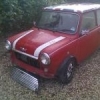
Dtm On A Standard 1275
#1

Posted 24 July 2012 - 12:01 AM
#2

Posted 24 July 2012 - 12:12 AM
The LCB and pipework are what makes the differnce, pick your favourite looking end and go with it.
Assuming your current exhaust is fitted onto an LCB and not mated somehow onto the original pipe work you may be able to get away with just the back silencer in replacement. Measure your current pipework though
#3

Posted 24 July 2012 - 12:20 AM
Ok cheers budProviding you have 1 3/4" pipework up to the rear silencer box and a good quality LCB (reads Maniflow) then what's on the back end of the box is academic at best in terms of performance. Any back pressure you were going to be getting will be provided by the 3m of pipework before that.
The LCB and pipework are what makes the differnce, pick your favourite looking end and go with it.
Assuming your current exhaust is fitted onto an LCB and not mated somehow onto the original pipe work you may be able to get away with just the back silencer in replacement. Measure your current pipework though
#4

Posted 24 July 2012 - 07:52 PM
Providing you have 1 3/4" pipework up to the rear silencer box and a good quality LCB (reads Maniflow) then what's on the back end of the box is academic at best in terms of performance. Any back pressure you were going to be getting will be provided by the 3m of pipework before that.
The LCB and pipework are what makes the differnce, pick your favourite looking end and go with it.
Sorry but that is not correct.
For optimum exhaust performance the molecules of exhaust gas need to exit the final pipe at the same speed as they travel along the exhaust pipe. If the end pipe suddenly has increased cross-sectional area then, according to Bernoulli's Theorem, the gas velocity decreases and the pressure increases. This causes inefficiency and loses power. The ideal internal diameter for a 1275 is 1.75" and that includes the single tailpipe.
#5

Posted 24 July 2012 - 07:59 PM
And while you're totally correct and I agree, I didn't say no loss, I said minimal. Compared to the other option of running a hoofing 2" i/d straight pipe all the way from the manifold, a twin exit box is a negligible loss.
While anything that deviates from the absolute is technically sub optimal, it would be interesting to see real world data on the logged differences caused by the last 4" of tail pipe.
Speaking theoretically, what happens when the gases exit the tail pipe? Surely a wider tip causes the same effect as when the gas exits the exhaust entirely?
Edited by Skortchio, 24 July 2012 - 08:02 PM.
#6

Posted 24 July 2012 - 08:00 PM
Edited by minimarco, 24 July 2012 - 08:03 PM.
#7

Posted 24 July 2012 - 08:07 PM
Is there a perfect length then? Is there a difference between going from a 1.75" bore to a 3" section than from 1.75" to atmosphere? for example, the first scenario would see exhaust travel through, say, a meter of 1.75" pipe before an expansion to 3" while the second scenario would see a meter and a half of 1.75" before an expansion to atmosphere.
Exactly my point, except the Maniflow tail section is 1.75" i/d just with 2 exits from the silencer as far as I'm aware. So 98% of the system is optimal and only the last 15cm or so are not. The twin tip is just lowering the overall effective length of the exhaust system marginally.
Far less though than a centre exit system compared to side exit, yet people use these with good effect.
While I appreciate the academics, in a real world enviroment do you spend more time exploiting every last bhp your car has or more time admiring the exhaust tone, appearance and driving at a steady pace easily maintainable without that extra fraction of a bhp?
Edited by Skortchio, 24 July 2012 - 08:15 PM.
#8

Posted 24 July 2012 - 08:29 PM
I've not done any measurements of power loss and increased fuel consumption when using suddenly larger diameter end pipes, but I believe others, like Keith Calver (who is to be respected) have and the loss is quite significant.
Why anyone would want to fit a super exhaust like a 1.75" Maniflow and then spoil it with a huge tail-pipe I don't understand. My 'S' has a 1.75" exhaust system, gives around 115 bhp at 6400 and goes very well indeed.
#9

Posted 24 July 2012 - 08:33 PM
#10

Posted 24 July 2012 - 08:34 PM
How does the gas know it's an exhaust pipe and not the atmosphere?
Can you clarify which pressure increases as a result of the larger exit pipe? I can't fathom how a greater throughput area would increase pressure?
I'm trying to understand how the difference could noticibly effect the running of the engine, when the effective length of a centre exit is notably shorter than a side exit (even minus tail tip) yet these aren't shunned in the same fashion.
As far as 'spoiling and exhaust' I believe that is personal taste, depending on application minimal loss of performance can be considered fair trade off for more desirable asthetics.
Edited by Skortchio, 24 July 2012 - 08:36 PM.
#11

Posted 24 July 2012 - 08:55 PM
Edited by konyo, 24 July 2012 - 08:55 PM.
#12

Posted 24 July 2012 - 09:07 PM
The local pressure increase in the end pipe influences the performance of the entire exhaust and, if you look at, say, a F1 car, the exhaust pipes are a constant diameter.
I think, from memory, that Keith Calver identified power losses as high as 4 to 5 bhp with these over-sized tail pipes, this representing about 6% to 8% loss and a consequent increase in fuel consumption.
But, if a huge and noisy exhaust is considered 'cool and stylish' (by whom?) then accept the power loss.
#13

Posted 24 July 2012 - 09:09 PM
Edited by mini-luke, 24 July 2012 - 09:10 PM.
#14

Posted 24 July 2012 - 09:18 PM
#15

Posted 24 July 2012 - 09:18 PM
Those losses were with a mere 2'' system by the way. He also commented on the dramatic increase in noise
I know it's a personal thing, but I can't understand why anyone would want to put huge exhausts on what is a genuine classic car just to make a lot of noise! What style statement is the noise supposed to be making?
Do you have the actual figures as identified by Keith C.? I do know they were quite significant as a percentage of total potential power.
1 user(s) are reading this topic
0 members, 1 guests, 0 anonymous users



















